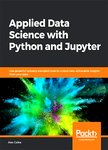版权所有:内蒙古大学图书馆 技术提供:维普资讯• 智图
内蒙古自治区呼和浩特市赛罕区大学西街235号 邮编: 010021

I S B N:(纸本) 9781789958171
出 版 社:Packt Publishing
出 版 年:2018年
主 题 词:Jupyter Jupyter Notebook Jupyter Python Interactive Computing Interactive Computing Web Application Jupyter Data Science Jupyter configuration Jupyter R Jupyter visualization
学科分类:0711[理学-系统科学] 12[管理学] 1201[管理学-管理科学与工程(可授管理学、工学学位)] 07[理学] 08[工学] 081104[工学-模式识别与智能系统] 0835[工学-软件工程] 081101[工学-控制理论与控制工程] 0811[工学-控制科学与工程] 071102[理学-系统分析与集成] 081103[工学-系统工程] 0812[工学-计算机科学与技术(可授工学、理学学位)]
摘 要:Become the master player of data exploration by creating reproducible data processing pipelines, visualizations, and prediction models for your applications. Key Features • Get up and running with the Jupyter ecosystem and some example datasets • Learn about key machine learning concepts such as SVM, KNN classifiers, and Random Forests • Discover how you can use web scraping to gather and parse your own bespoke datasets Book Description Getting started with data science doesn t have to be an uphill battle. Applied Data Science with Python and Jupyter is a step-by-step guide ideal for beginners who know a little Python and are looking for a quick, fast-paced introduction to these concepts. In this book, you ll learn every aspect of the standard data workflow process, including collecting, cleaning, investigating, visualizing, and modeling data. You ll start with the basics of Jupyter, which will be the backbone of the book. After familiarizing ourselves with its standard features, you ll look at an example of it in practice with our first analysis. In the next lesson, you dive right into predictive analytics, where multiple classification algorithms are implemented. Finally, the book ends by looking at data collection techniques. You ll see how web data can be acquired with scraping techniques and via APIs, and then briefly explore interactive visualizations. What you will learn • Get up and running with the Jupyter ecosystem • Identify potential areas of investigation and perform exploratory data analysis • Plan a machine learning classification strategy and train classification models • Use validation curves and dimensionality reduction to tune and enhance your models • Scrape tabular data from web pages and transform it into Pandas DataFrames • Create interactive, web-friendly visualizations to clearly communicate your findings Who this book is for Applied Data Science with Python and Jupyter is ideal for professionals with a variety of job descriptions ac